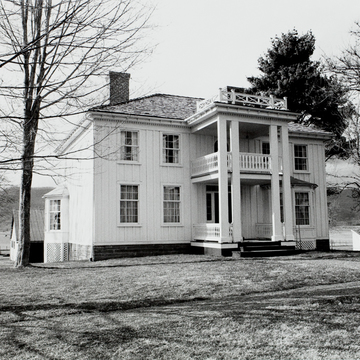Pulitzer and Nobel prize winner Pearl Sydenstricker Buck reminisced about her West Virginia birthplace in My Mother's House. “Underneath the white painted wood, the house, she told me, was of red brick. I imagine that my great-grandfather and my grandfather, being city men of Utrecht, Holland, did not like the idea of living in a wooden house. The inner structure, doubtless, they thought should be of stronger stuff.” Comparing it to other area houses, she recalled that her maternal ancestors, the Stultings, “who were not forest people,… had no conception of what it meant to build even a simple log cabin.” They were “accustomed to theater and music and books,” and her mother's house “was enlivened with memories of European culture.”
The Stulting house, with its two-story portico, was indeed elegant for its time and place. The overall form and proportions are Greek Revival, but a one-story polygonal bay, the only asymmetrical feature of the five-bay facade, strikes an Italianate note. The board-and-batten siding (Buck's “white painted wood”) over brick-nogged walls is unusual for a house of this size and formality. The interior arrangement follows a double-pile, central-hall plan.
Pearl Buck was born here on June 26, 1892, while her missionary parents were home on furlough. When she was only several months old, they took her back to China and reared her
Although Buck's maternal ancestors “had no conception of … a simple log cabin,” the paternal Sydenstricker clan did. Her father, a Greenbrier County native, was born in a log house dating from 1834. In 1977 that house was reconstructed on the grounds of Buck's birthplace. The houses share a fenced curtilage, with pastureland and barns in the distance: essentially the same bucolic, rural scene that Pearl Buck remembered so fondly.





